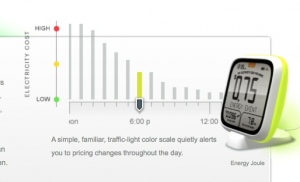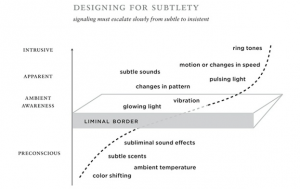Ambience, Ubiquity, and Assistance
This was prompted by David Rose’s Enchanted Objects — he breaks what I’d loosely characterize as computational assistance into four categories:
- Terminal World — slabs (phones, tablets), and more conventional computers. You come to them in their world, they don’t genuinely inhabit yours. This becomes clearer when contrasted with the following three categories.
- Prosthetics — medical prosthetic devices, including those used for enhancement
- Animism — social robots, think of Jibo
- Enchanting Everyday Objects — Here Rose is primarily discussing discrete objects that can assist you while being “just” objects in the world. A paradigmatic example here is an umbrella that lights up when you’re leaving the house and rain is predicted
Rose has been involved with a number of startups in this space including Ambient Devices and Vitality.
Ambient Devices started off making what I’d term a generic glanceable device. In theory, it could be set up to take any one of a number of inputs and glow accordingly . I had one of the early ones that were geared toward weather. It operated a bit like the weather beacon on the old John Hancock tower in Boston; glowing red for rain, blue for clear skies, etc.
The device did get interesting press, but didn’t get sufficient uptake. Glanceable doesn’t quite work for weather — it only works if your weather question has a single value, e.g., “will it rain soon?” However, for more complex questions, e.g., will it snow during my evening commute, am I in danger of freezing to death if I wear a light jacket, etc., a glowing ball doesn’t help much. I assume that’s why I wasn’t the only one to abandon it for weather websites and weather apps.
The company pivoted a bit and turned to producing devices that give you glanceable information about your current energy costs (in areas with demand based electricity pricing). This is a perfect glanceable application: it can be captured as a single point on a single axis; it matters right now; it matters right where you are; and it sometimes changes frequently.
This image is from the Ambient Devices website (captured 15 August 2014)
Vitality’s glow cap, at first glance (sorry), looks similar: it provides almost glanceable reminders for patients to take their medication. However, upon further examination you find that there are some key additions that significantly enhance it’s capabilities:
- First, it’s not just the cap that glows. There is another light, similar to a nightlight, that can be placed in an area frequented by the patient.
- There’s also a sound component — if the light has been neglected, the cap will make a sound to attract attention.
- The device is also networked back to “central station” so that caregivers and family can be notified if too long a period has elapsed since patient last took the medication.
- The caps can have their dose time and frequency programmed through a website.
In most ways this isn’t as slick as the Philips medication dispenser. However, it meshes better with current pharmaceutical containers and has lower barriers to entry.
Since I mentioned Philips, I should say that they discuss ambient a great deal. However, looking at the research (which admittedly is a decade old at this point), I find it to be geared more towards ubiquity than ambience. Admittedly the terms overlap a great deal: ambience is served by ubiquitous computation (computers everywhere), but ubiquity without ambience means having terminals and flat screens everywhere with little, if anything by the way of animism or enchantment. If I had to guess, it’s because the project described is dated. It’s long before the Internet of Things with its paradigm of small, low-cost, wireless sensors everywhere was potentially practical in the near-term.
I expect to see more from them in the future, if for no other reason than that the Philips Hue lightbulbs are a profound enabler of this kind of thing: remotely controlled bulbs with highly adjustable color and light levels is major.
Ambience
I’ll stake a claim that true ambience requires all four of Rose’s modalities:
- We need terminals for some things, e.g, our longer-term weather forecast.
- Prosthetics, if they are necessary for the life of the resident, could potentially be incorporated (I don’t know enough about them to say anything more).
- I suspect that some animated devices, like Jibo or a Sony Aibo (sadly, long discontinued)O provide for much different affordances than a device which glows or beeps. They would be much more intrusive, for sure, but if designed to be cute enough they would be a welcome addition to most households.
- Finally the enchanted objects: the glowing lights, beeping bottle caps etc., which provide subtle unobtrusive reminders for our day-to-day life.
Ranges of “ambient” interaction.
Enchanted Objects provides the following diagram that delineates degrees of intrusion for subtle interactions:
The main caveat here is the assumption that the target of the interaction has sensing capabilities in the normal range: when designing for the elderly or handicapped, the values should be modified appropriately.
It is useful to think of the designs discussed in the book as being one-place deictic references, e.g., “this is x” where the reference serves as a cue and the referent and the state are unambiguous. This is true even in the case of the pill bottle and its ancillary light in the living room, in which everything is around medication (the product literature specifies that the systems can handle multiple pill bottles, but I’m unclear as to how that works and also unclear as to how the system works if more than one resident of the home is using the system).
However, when considered from the perspective of an overall system, there’s no reason why one couldn’t design systems which allow for two placed deictic references, e.g., “pay attention to y which is x.” This is a relatively common design motif and has been used with many way finding systems from static “where’s the bathroom” signage systems to dynamic, stressful emergency situations “the plane is on fire, follow the lights to the exit”
The Importance of Animism
Although he has a nice little writeup about it, Rose isn’t particularly drawn towards animistic solutions. As mentioned, I’m confident that animistic devices can easily be part of the overall solution space once they become practically available for the home environment.
This will probably take a while. Jibo has been criticized for being “immobile,” even though it isn’t strictly true: the base is in a fixed location, but it has a few axes of rotation, allowing for some freedom of movement. For these devices to be effective assistants they will have to exhibit an ambient aspect: mostly in the background when unwanted/unneeded. My model here is that good animist devices will be treated like toys or pets, depending upon their capability, but will have ambient cueing capability when the situation requires it. Rose has a couple lines that capture the essence:
Again, Stanford’s Clifford Nass has useful research to contribute. In 1996, he investigated how people would react toward robots that seemed to be reacting to them in particular ways. In his experiments, people were much more willing to perform a tedious exercise for helpful computers than for nonhelpful ones. Nass’s findings support the argument that we develop humanlike relationships with nonhuman objects.”
“ I believe we will want our service providers to be “personalitied”—to have just the right amount of human character and hyperspecialization so we don’t feel threatened or overshadowed and can remain in the comfortable role of generalist.”
The more mobility the animist system posses the better, a device which can easily traverse steps and stairs is much more useful (especially in the Timmy’s stuck in the well scenario) than a device that isn’t mobile. Mobile systems could also reduce system complexity by reducing the number of fixed cueing devices that need to be wired in at installation.
In summary, I think that the best enchanted objects will be parts of an enchanted environment, where we get our weather from a luminous slab, are reminded to take our pills by a luminous (& occasionally beeping) pill bottle, and are led to our glasses by our robot cat.



Leave a Reply